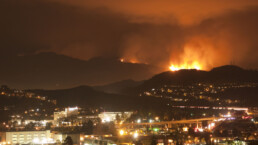Blame climate change, El Niño, and a dose of bad luck.
by Zoya Teirstein, Grist
It has been a chaotic start to the Northern Hemisphere’s “danger season,” those few months of the year that are accompanied by a parade of disasters. This year’s danger season already includes abnormally high sea-surface temperatures in the world’s oceans, catastrophic wildfires in Canada, and unusual flooding in California.
Experts say recent extremes are being influenced by a hodgepodge of distinct factors. Climate change is involved, but natural variations in global weather, and an unfortunate dose of serendipity, are also at play.

“Global warming itself hasn’t suddenly accelerated this year,” Daniel Swain, a climate scientist at the University of California, Los Angeles, said in a live briefing on Monday. “Part of what’s going on is random bad luck.”
Last week, the U.S. National Atmospheric and Oceanic Administration announced that El Niño conditions — above average sea-surface temperatures that spur higher-than-usual warmth in many parts of the world — were officially present in the Pacific Ocean. The swing from La Niña, El Niño’s opposite extreme, to an El Niño means a much warmer year is in store for the entire globe. But the cycle, which is associated with extremes such as drought and severe storms, also has localized impacts. In eastern and southern Africa, the Horn of Africa, Latin America, the Caribbean, and parts of the Asia-Pacific region, El Niño can spur famine, outbreaks of infectious disease, and heat stress. The natural weather phenomenon may also be having an impact, Swain said, on record-breaking land surface temperatures in Canada that have helped to fuel its devastating fire season so far.
Recent Posts
‘Unconstitutional. Unethical. Authoritarian.’ ICE Bars Millions Of Immigrants From Bond Hearings
July 18, 2025
Take Action Now One watchdog said the new policy “seems like a blatant attempt to stop them from exercising their right to due process.”……
Americans Are Not Nearly Alarmed Enough About Climate Change
July 18, 2025
Take Action Now Americans still don’t comprehend how imminent, dangerous, and far-reaching the threat is—and journalists are partly to blame.By…
The IRS Is Building A Vast System To Share Millions Of Taxpayers’ Data With ICE
July 17, 2025
Take Action Now ProPublica has obtained the blueprint for the Trump administration’s unprecedented plan to turn over IRS records to Homeland Security…
Israel’s Sudden Assault On Syria Is Unchecked Aggression
July 17, 2025
Take Action Now Jerusalem is bombing Damascus and threatening al-Sharaa’s rule, while Washington was hoping to help the nascent government on…




